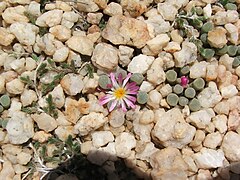Frithia pulchra
| Frithia pulchra | |
|---|---|

| |
| Scientific classification | |
| Kingdom: | Plantae |
| Clade: | Tracheophytes |
| Clade: | Angiosperms |
| Clade: | Eudicots |
| Order: | Caryophyllales |
| Family: | Aizoaceae |
| Genus: | Frithia |
| Species: | F. pulchra
|
| Binomial name | |
| Frithia pulchra | |
Frithia pulchra, the fairy elephant's feet,[2] is a species of flowering plant in the fig‑marigold family Aizoaceae, endemic to Gauteng Province, South Africa (where it is classified as "Vulnerable" by the IUCN Red List). Its natural habitat is temperate grassland with high summer rainfall. A tiny stemless succulent growing to just 10 cm (3.9 in) tall and 20 cm (7.9 in) broad, it has bulbous oblong leaves with leaf windows at the tip; and magenta and white daisy-like flowers in winter.[3] During periods of drought it has the ability to shrink beneath the soil surface, thus avoiding excessive desiccation, but making it extremely difficult to find.[3]
It is named for Frank Frith, a Johannesburg gardener who showed specimens to N.E. Brown, a botanist at Kew Gardens, while on a visit to London, UK, in 1925.[4] The Latin specific epithet pulchra means "beautiful".[5]
It does not survive frosts, so in temperate areas it needs to be cultivated under glass. In the UK it has gained the Royal Horticultural Society's Award of Garden Merit.[2][6]
Gallery[edit]
-
Wild plant
-
Flowering in its natural habitat
References[edit]
- ^ Pfab, M.F. (Gauteng Nature Conservation).; Victor, J.; et al. (National Botanical Institute) (2003). "Frithia pulchra". IUCN Red List of Threatened Species. 2003: e.T44082A10849614. doi:10.2305/IUCN.UK.2003.RLTS.T44082A10849614.en. Retrieved 18 November 2021.
- ^ a b "RHS Plantfinder - Frithia pulchra". Retrieved 16 February 2018.
- ^ a b "Frithia pulchra". SANBI PlantZAfrica.com. Retrieved 27 February 2018.
- ^ "How to grow and care for Frithia". World of Succulents. 10 August 2015. Retrieved 27 February 2018.
- ^ Harrison, Lorraine (2012). RHS Latin for Gardeners. United Kingdom: Mitchell Beazley. ISBN 978-1845337315.
- ^ "AGM Plants - Ornamental" (PDF). Royal Horticultural Society. July 2017. p. 39. Retrieved 27 February 2018.
External links[edit]
 Media related to Frithia pulchra at Wikimedia Commons
Media related to Frithia pulchra at Wikimedia Commons- 2006 IUCN Red List of Threatened Species. Downloaded on 21 August 2007.




